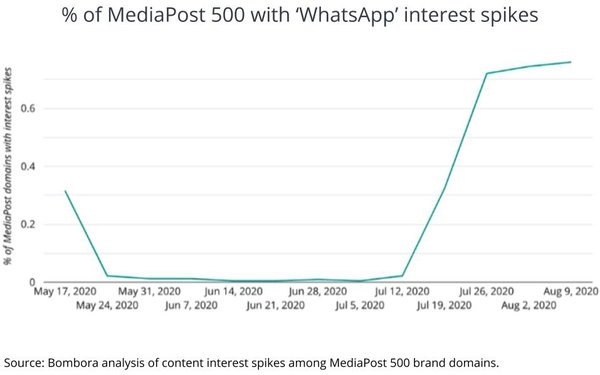Interest Soars For ‘WhatsApp,’ ‘Attention Analytics,’ Declines For ‘Price Sensitivity’

Brands and agencies often behave in ways one would expect, particularly in the current environment. Other times, intent data reveals something completely unexpected.
Below, we look at two trends that come as little surprise — spikes in intent around an exciting advertising medium and around a term adjacent to customer experience — and one that indicates a level of complacency with a topic that goes hand-in-hand with our economic circumstances.
We’ve known for some time that ads were coming to Facebook-owned WhatsApp, and it seems as if advertisers are getting ready to scale that engagement — if brand/agency search terms are any indication of what’s in store for the world’s largest messaging platform.
As the lines between work and business continue to blur, mobile phone users are expecting to use chat and messaging apps to communicate with businesses more regularly over the next two years.
The move also brings some parity with Facebook and Instagram — which offer similar in-app ad features.
Brands’ interest in “Attention/Engagement Analytics” rose dramatically at the start of August, according to Bombora. Within the context of huge increases in online consumption, marketers will need to be more proactive and more nimble in addition to being able to anticipate customer expectations and needs.
Now is the time to invest in the data, technology, and systems required to deliver exceptional experiences. However, these tools should not be viewed as a short-term strategy stemming from society’s newfound reliance on digital technologies. A company-wide understanding of customer engagement should be a standardized, cross-departmental practice.
“Price Sensitivity,” which essentially measures of the impact of price points on consumer purchasing behaviors, hit an all-time low in early August as we approach six months since COVID-19 was declared a global pandemic. In this time frame, various sectors, from air travel to manufacturing, experienced sharp drops in demand, excess capacity, and heightened price sensitivity — which drove down prices and eroded value.
For consumers, the global crisis triggered a disruption, moving their “habitual” purchase decisions to more “deliberate” shopping behavior.
Despite any short-term indications, consumer consumption and their “willingness to pay” for certain products and services can change from one day to the next depending on lockdown restrictions, travel bans, news and economic conditions.
What we’re seeing in this graph may indicate adjustment to a new normal: brands are now well acquainted with the effect the pandemic has had on their customers’ propensity to buy.
(48)